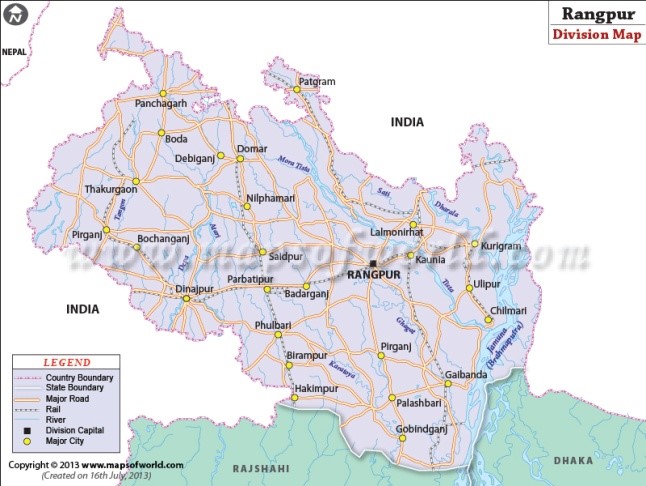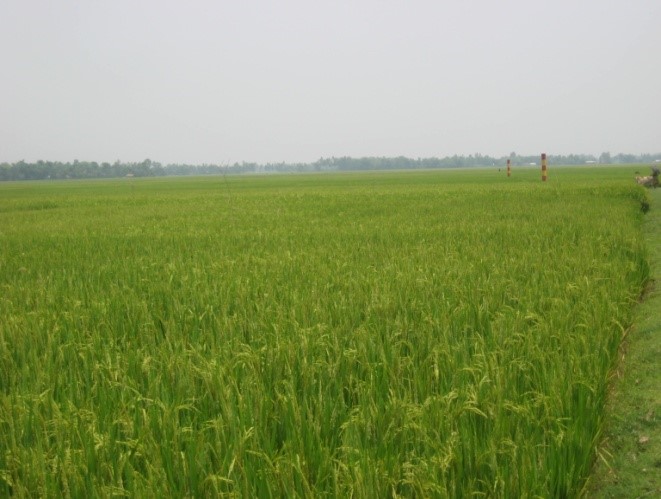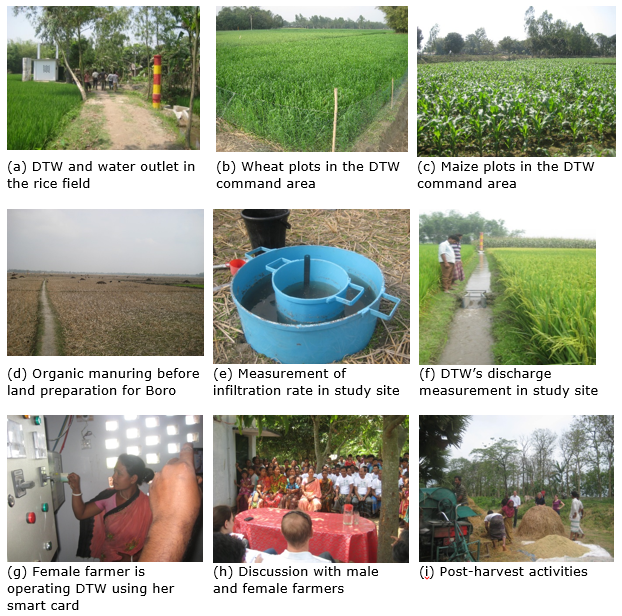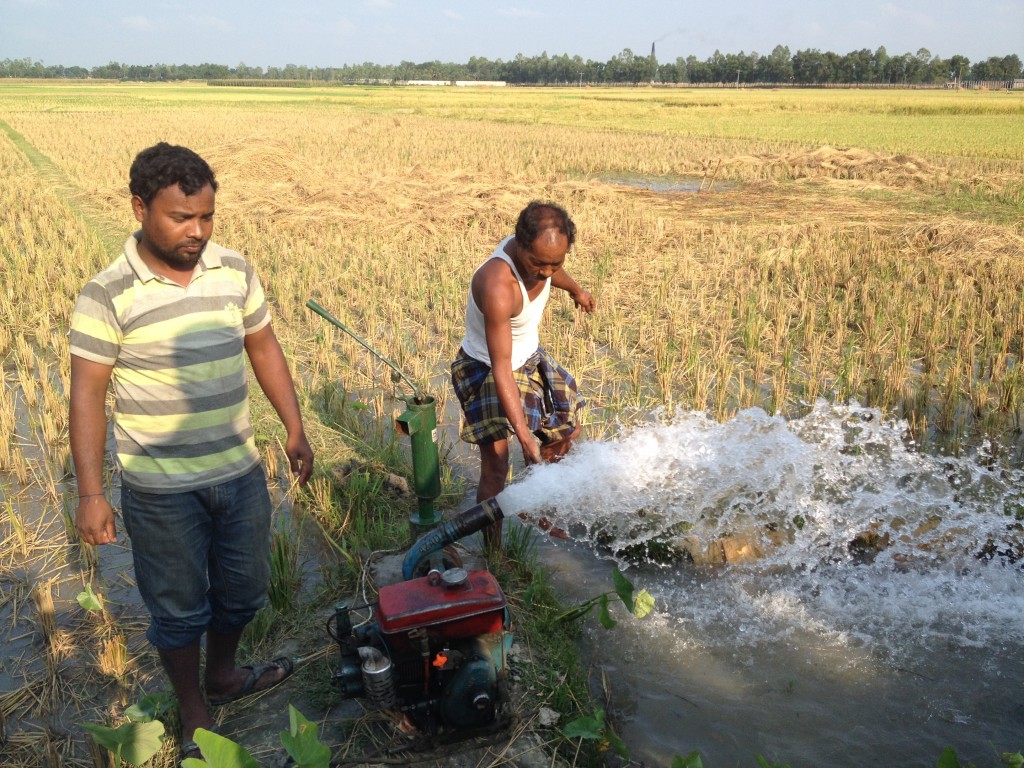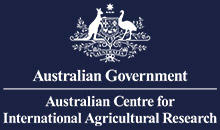By Md Maniruzzaman and Md Mainuddin
Introduction:
Technical, social and economic constraints are limiting the effective use of groundwater and ponds for irrigation in many parts of the EGP. Large areas of land remain fallow during the dry months. Access to year-round water for irrigation would significantly improve the productivity of agriculture, improving incomes and food security.
Marginal and tenant farmers, youth and women are particularly vulnerable and could benefit from a new approach to irrigation provision. This project is researching and demonstrating improved collective farming systems for marginal farmers and improved water management and irrigation practices using efficient systems appropriate to the needs of the marginal farming communities.
A project funded by the Australian Centre for International Agricultural Research (ACIAR) is working with communities across Nepal (Saptari), India (Cooch Behar and Madhubani) and Northwest Bangladesh, to research and demonstrate sustainable social and biophysical interventions.
Fig. 1 Location and view of Village Dhodogaon, Thakurgaon
Village:
The village Dhandogaon is located in the Thakurgaon Sadar Upazila (sub-district) of Thakurgaon district, in the northwest region of Bangladesh under the Agro-ecological Zone (AEZ)-1. The land type is medium highland to highland. The region consists of Old Himalayan Piedmont Plains with loam to clay loam soils and characterised by medium monsoonal rainfall and are comparatively dry in winter months. The temperature is comparatively cooler in winter and hot in summer. The village community is mainly dominated by the lower caste Hindus; some tribal people also live there. The average size of land holding is low with a high proportion of marginal and tenant farmers (about 60%).
Agriculture is the main source of livelihood for the village people. Most of the tenant farmers work as agricultural labourers (about 25% women labourers). There is migration of youth to other places in search of alternate occupations. The village is rich in groundwater resources. However, most of the ponds are seasonal and only 10-15 ponds retain water throughout the year and are used for culture fisheries, duck rearing, cattle bathing and household uses. The groundwater table is available at about 5.0 to 6.5 m below ground level. Barind Multipurpose Development Authority (BMDA) installed two deep tubewells (DTW) in the village. Beyond the command area farmers are also using shallow tubewells (STW) for irrigation. BMDA managed DTWs are electrified and most of the STWs are run by diesel fuel. The quality of groundwater resources is good.
Fig. 2 (a-i) Different activities at Site I: Dhandogaon, Thakurgaon
Community and interventions:
The DTW site at Dhandogaon village represents the Barind Tract area of northwest Bangladesh. This DTW is installed and managed by BMDA. This village is selected for understanding the bio-physical, socio-economic and institutional management of DTW irrigation systems in northwest Bangladesh and to draw a comparison to the other project sites in India and Nepal. BRRI and CSIRO is studying the bio-physical aspects and IWMI is looking after the socio-economic aspect of that village. There are about 80 farming families within the DTW command area and most of them represents marginal and tenant group. There are also 12-15 women farmers within the DTW command area. The DTW farmers are selected for collecting secondary social and bio-physical data by the project. As part of the project activities social mobilisation was done at the site through a series of community meetings, focus group discussions, community engagement programs and gender awareness meetings.
The analysis of agricultural data of the site reflected the dominance of rice based cropping system. The main cropping pattern is Boro-Fallow-T. Aman. Some non-rice crops (Maize, Wheat, Potato, Mustard and Chili) are also grown in the area during winter. The irrigation system consists of pump house, buried pipe distribution system and earthen plot channels. The irrigation infrastructures are developed by BMDA. Plot channels are maintained by the farmers. Electrified pump is operated by digital control panel. Pre-paid smart cards are used by the water users to receive irrigation water in their fields. Irrigation charge is time based. Thus efficient irrigation water distribution is ensured. Boro rice requires huge amount of water, which creates tremendous pressure on groundwater resources.
Therefore, the project scientists recommend low water demanding crops like mustard, wheat, potato and maize at early winter followed by late Boro for crop intensification and improvement of productivity. With technical advice of the project scientists the farmers are interested to cultivate about eight hectares of low water demanding crop. Some farmers cultivated late Boro after winter crops for minimising the irrigation demand as crop receives sufficient rainfall at the later part of the growing season. AWD irrigation scheduling is advised for saving field level irrigation water. Some farmers have started to adopt the technology.
Impact:
Though the project is in the field for the 1st season. The main objective of this season is to understand the current practice and performance of the system. This is expected to enable us to select most appropriate intervention to test in the field in the second season to improve system efficiency and productivity. However, some interventions have been made for saving irrigation water and increasing land productivity. Our research has clearly showed visible impact on the conventional agricultural practices of the farmers. Due to strengthening of the project activities and social engagement, the farmers have started to realise the benefits of improved water and crop management practices. For increasing support from the project, farmers are now more interested to adopt new crops and management practices. The cropping intensity has increased in some lands due to intensive cropping system. With better water management techniques and improved cultivation practices the overall cost of cultivation has been reduced. With higher yield and timely harvesting of the crops the market prices are more remunerative to the farmers.
Future:
Training programs will be arranged for farmers groups on ‘efficient water management for crop production’. This is to build up their capacity on resources conservation, productivity improvement and cost minimisation so that they can sustain beyond the project duration. Technical training and hands-on exposure will be given to the farmers to improve their agricultural skills. New varieties of crops, low water requiring crops and high value cash crops will be introduced in the future. Special emphasis will be given to minimise the cost of production by optimum use of irrigation water. Improvements in field level water application will ensure reduced cost of cultivation.




